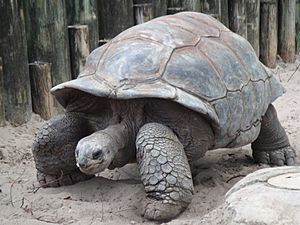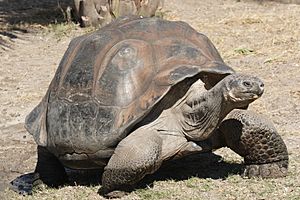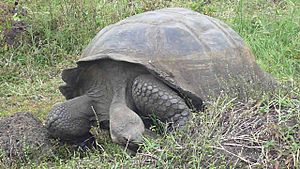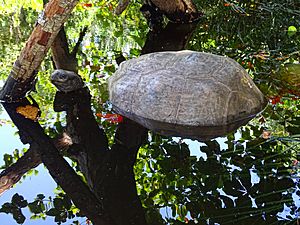Giant tortoise facts for kids
Giant tortoises are amazing creatures that have grown very large on different tropical islands. They can weigh as much as 417 kilograms (919 pounds) and grow to be 1.3 meters (4 feet 3 inches) long. These gentle giants live, or used to live, on islands like the Seychelles, the Mascarene Islands, and the Galápagos Islands.
Today, the biggest group of giant tortoises lives on Aldabra Atoll in the Seychelles. There are about 150,000 of them there! Even though they look similar, the tortoises from the Seychelles and Mascarenes came from nearby Madagascar. The Galapagos tortoises came from Ecuador. Their similar looks, even though they came from different places, is called convergent evolution.
These tortoises can live for over 100 years in the wild. This makes them the longest-living vertebrates (animals with backbones). Some have lived even longer! For example, a tortoise named "Tu'i Malila" from Madagascar lived to be 188 years old. "Harriet" was 176 when she died in 2006. And an Aldabra giant tortoise named "Adwaita" was thought to be around 255 years old when he passed away in 2006!
Sadly, when these islands were first explored, many tortoises were caught and killed for food. Sailors found them easy to catch and store on ships for a long time. Because of this, they almost disappeared by the year 1900. Luckily, giant tortoises are now protected by strict laws. They are considered threatened species, meaning they are at risk of extinction.
Contents
Galápagos Giant Tortoise
The Galápagos giant tortoise (Chelonoidis nigra) is the largest living species of tortoise. It is also the 10th-heaviest living reptile on Earth.
Where They Live
These tortoises live on seven of the Galápagos Islands. These islands are a group of volcanic islands about 1,000 kilometers (620 miles) west of Ecuador. Spanish explorers found the islands in the 16th century. They named them "Galápagos" after the Spanish word for tortoise.
Shell Shapes and Why They Matter
The size and shape of their shells are different depending on where they live. On islands with humid highlands, the tortoises are larger. They have domed shells and short necks. On islands with dry lowlands, the tortoises are smaller. They have "saddleback" shells and long necks.
Charles Darwin noticed these differences when he visited the islands in 1835. His observations helped him to develop his theory of evolution. This theory explains how living things change over time.
What They Eat
Galápagos tortoises are herbivores. This means they only eat plants. They mostly munch on cactus pads, grasses, and native fruits. They can drink a lot of water when it's available. They can also store water in their bladders for a long time.
The saddle-backed tortoises are smaller. They have very long necks and legs. They live in dry areas and eat cactus. The domed tortoises are bigger with shorter necks and legs. They live on islands with more plants and eat grass.
Daily Life
These tortoises spend about 16 hours a day resting. How active they are depends on the temperature and how much food is around. In the cool season, they are active around midday. They sleep in the morning and afternoon. In the hot season, they are active early in the morning and late in the afternoon. During the hottest part of the day, they rest in the shade or in muddy puddles to stay cool.
Saving the Galápagos Tortoise
The number of Galápagos tortoises has dropped a lot. In the 16th century, there were over 250,000 of them. By the 1970s, this number fell to about 3,000. This decline happened because too many were hunted. Their homes were also destroyed. New animals like rats, goats, and pigs brought to the islands also caused problems.
Out of the original fifteen types of Galápagos tortoises, ten still live in the wild. One type (C. n. abingdoni) had only one known tortoise left, named "Lonesome George." He lived in captivity and sadly died in June 2012.
Many people have worked hard to save these tortoises. Thousands of young tortoises raised in captivity have been released back onto their home islands. Because of these efforts, the population grew to 19,000 by the early 21st century. However, the species is still considered "vulnerable" by the International Union for the Conservation of Nature (IUCN). This means they still need our help to survive.
Aldabra Giant Tortoise
The main group of Aldabra giant tortoises lives on the islands of the Aldabra Atoll in the Seychelles. This atoll has been protected from human activity. It is home to about 100,000 giant tortoises. This is the largest group of these animals in the world.
Another small group lives on Changuu island, near Zanzibar. Other tortoises are kept in special parks in Mauritius and Rodrigues to help protect them. These tortoises live in many different places. This includes grasslands, low scrub, mangrove swamps, and sandy coastal areas.
The scientific names for this species are Aldabrachelys gigantea or Dipsochelys dussumieri. Both names refer to the same tortoise.
Appearance and Adaptations
Aldabra giant tortoises have large, dome-shaped shells. These shells protect their soft bodies inside. They also have long necks. This helps them reach leaves on higher branches of trees.
Male tortoises are not much bigger than females, but they can weigh almost 100 kilograms (220 pounds) more. They move slowly. They have small, thick legs and round, almost flat feet. These feet help them walk on sand.
Where They Live and What They Do
Aldabra giant tortoises mostly live in grasslands and swamps on the Aldabra Atoll's islands. These islands are part of the Seychelles in the Indian Ocean. In the past, they shared the islands with other giant tortoise species. But many of those were hunted to extinction in the 1700s and 1800s.
Even though they usually stay in areas with lots of low plants, they will travel to places with fewer plants and rocks if food is hard to find. On hot days, they can be seen resting in shady spots or shallow pools of water to cool down. Aldabra giant tortoises spend their lives grazing on plants. They can travel surprising distances to find food. They can also drink from very shallow pools using their nostrils.
Images for kids
-
Lonesome George, the last known individual of the Pinta giant tortoise (C. n. abingdonii)









